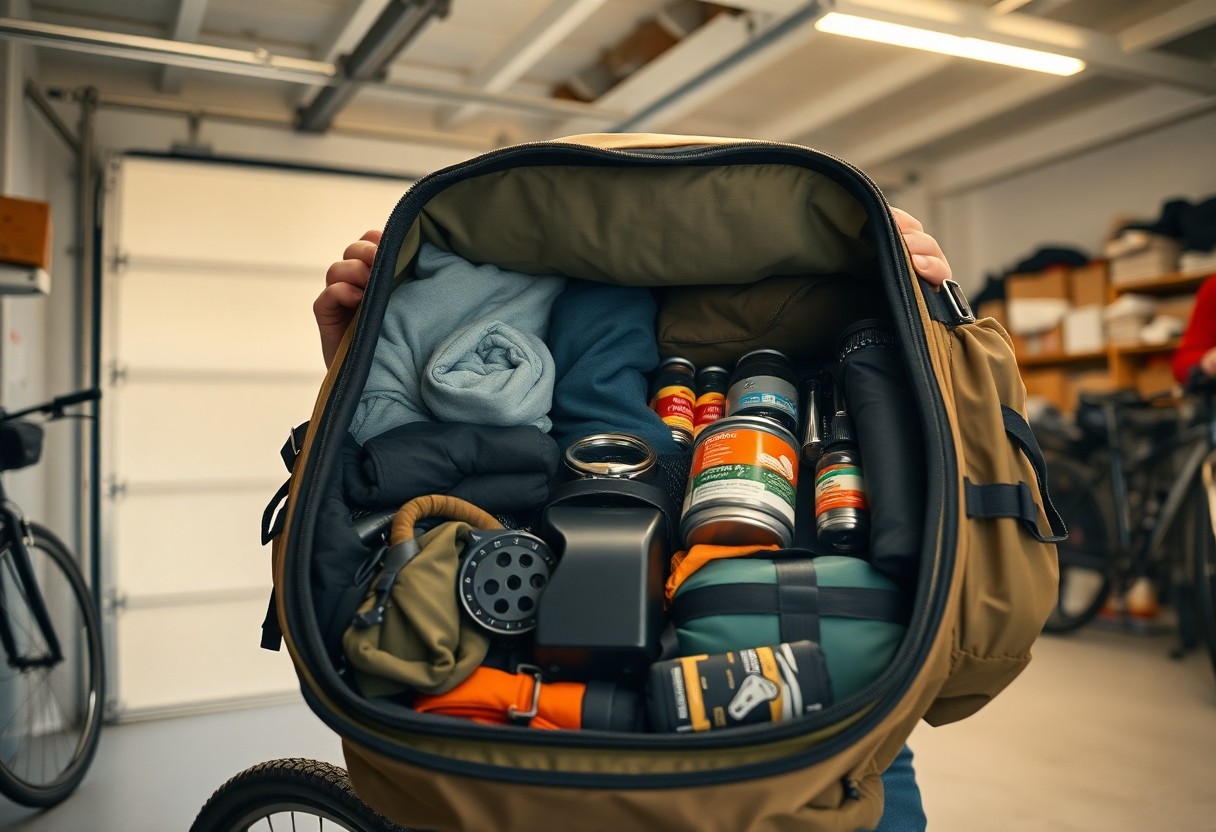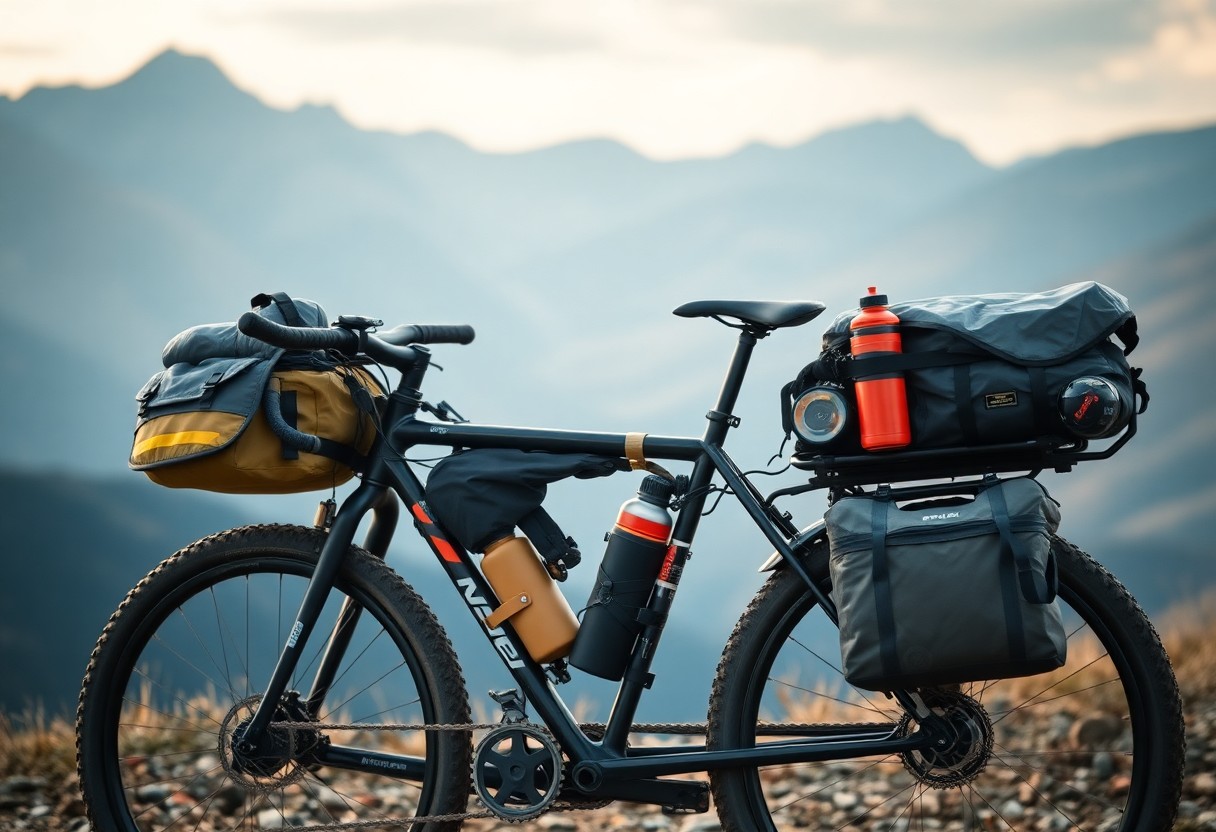Packing efficiently for a multi-day bikepacking expedition can significantly enhance your experience, allowing you to focus on the journey rather than the logistics. Your gear choices will influence your comfort and safety on the trail, so it’s crucial to pack wisely. Prioritise lightweight crucials and ensure you have the right tools for emergencies. Organise your items into categories, taking into consideration your route and weather conditions. By planning ahead and choosing carefully, you can make your adventure both enjoyable and memorable.
Key Takeaways:
- Prioritise lightweight and compact gear to maximise efficiency and minimise weight while packing.
- Organise your items by function and accessibility, ensuring frequently used items are easily reachable.
- Utilise versatile equipment that serves multiple purposes, reducing the overall number of items needed.
The Essentials of Bikepacking Gear
The right gear determines the comfort and success of your multi-day bikepacking journey. Selecting lightweight and durable equipment can enhance your experience significantly. You’ll want to focus on items that suit your environment and expected weather conditions while also ensuring that you have everything necessary for camping, cooking, and repair. Each piece of gear should serve a specific purpose and be practical enough to carry over long distances without weighing you down.
The Core Items You Can’t Do Without
Your bikepacking kit must include a few core items that are non-negotiable. At a minimum, this includes a reliable tent, sleeping bag, and mat, as well as cooking supplies like a portable stove and utensils. Tools and spare parts for your bike are also imperative, alongside weather-appropriate clothing and food supplies that keep well over a few days. This imperative gear will keep you safe and comfortable, ensuring you can focus on enjoying the ride.
Understanding the Role of Multi-Function Gear
Choosing multi-function gear can greatly reduce the weight and bulk of your pack. Items such as a tent that doubles as a tarp or a cooking pot that can serve as a bowl will save both space and effort. The versatility of these items not only enhances efficiency but also allows for greater adaptability across varied situations you encounter on the trail.
A solid example is a sleeping bag that zips open to become a quilt, offering flexibility for changing temperatures. Similarly, a bike frame bag can double as a dry bag for your clothes when you’re caught in rain, proving indispensable during those unpredictable weather conditions. By emphasising multi-functionality, you maintain a lightweight pack while ensuring you’re equipped for a multitude of scenarios, allowing for spontaneous adventures along your bikepacking route.

Strategic Packing Techniques
Streamlining your packing process involves utilising a few strategic techniques that ensure you carry everything you need without overloading your bike. Carefully consider the placement of items by keeping heavier gear closer to the centre of your bike’s frame and lighter items towards the periphery. This optimal arrangement will enhance your overall balance and riding efficiency, making it easier to navigate various terrains. Furthermore, adopting the right tools and methods can significantly ease your packing experience, turning your multi-day adventure into a smooth journey.
Prioritising Weight Distribution for Balance
To maintain stability and control during your ride, prioritising weight distribution is necessary. Distributing weight evenly across your bike, with heavier items located lower and closer to the frame, helps prevent wobbling and improves handling. Place items like your tent and sleeping bag in the rear panniers, while keeping lightweight necessarys in your front bags. This balanced approach allows for a more comfortable ride and reduces the risk of fatigue over long distances.
The Art of Compression: Maximising Space
Employing compression techniques can drastically increase your packing efficiency. Use compression sacks to reduce the volume of bulky items like sleeping bags and clothing, which can take up valuable space in your panniers. Opt for packing cubes or dry bags to organise smaller items, while ensuring you can swiftly access necessarys. This method not only condenses your gear but also streamlines your unpacking and repacking process at stops along the way, maximising your time spent enjoying the ride rather than fumbling with your belongings.
Consider investing in high-quality, lightweight compression sacks that are specifically designed for bikepacking. For instance, a sleeping bag from a reputable brand could compress to half its size, allowing you to fit it easily alongside other items without compromising on efficiency. Additionally, layering your gear in a sequence based on accessibility can save you from rummaging through your bags every time you need something. Through thoughtful compression and organisation, you can significantly enhance your bikepacking experience.
Food and Hydration: Fuel Your Adventure
Planning your meals and hydration is central to sustaining energy and performance throughout your bikepacking journey. Selecting items that not only fuel your body but also fit within your limited pack space can make all the difference. Focus on high-calorie, lightweight options that provide the necessary nutrients to keep you active and energised on the trails.
Choosing Lightweight, Nutrient-Dense Foods
Opt for foods such as dehydrated meals, nut butter packets, and trail mix that deliver high calories without excessive weight. Items like instant oatmeal or energy bars offer a convenient breakfast or snack while packing in crucial vitamins and minerals. Integrating a selection of dried fruits and jerky not only enhances flavour but also boosts protein intake for muscle recovery.
Hydration Solutions for Extended Journeys
Staying hydrated is vital, particularly during strenuous activity. Carrying a collapsible water reservoir or hydration bladder is an efficient means of managing your water supply. Consider using a lightweight water filter or purification tablets to refill from natural sources, ensuring you can access safe drinking water without excessive bulk.
Using a hydration bladder allows for quick sips while pedalling, keeping you consistently hydrated without stopping. Aim for a consumption target of around two to three litres a day, adjusting based on heat and exertion levels. If you’re traversing remote areas, verifying the availability of water sources through a pre-trip plan or downloadable maps can save you unnecessary struggles when thirst strikes. Also, bring along an additional water bottle for electrolytes or recovery drinks, helping to replenish lost minerals and prevent fatigue.
Navigating the Challenges of Remote Areas
Remote areas present unique challenges that can test your navigation skills and adaptability. Expect variable terrains, unexpected weather changes, and limited access to services. Familiarising yourself with your route beforehand and gaining an understanding of the regional terrain will enhance your confidence. Additionally, consider that long stretches may lack clear signage or mobile reception, making preparation and resourcefulness imperative for a safe journey.
Preparing for Possible Emergencies
Taking proactive steps to prepare for emergencies can significantly mitigate risks during your expedition. Always carry a well-stocked first-aid kit tailored to your specific needs, alongside imperative personal medications. Informing someone about your planned route and expected return can provide an added layer of safety should any unforeseen circumstances arise.
Tools and Resources for Navigation and Communication
Equipping yourself with reliable tools and resources for navigation and communication is paramount. Topographic maps, GPS devices, and compass skills can enhance your route-finding abilities. Additionally, mobile phones can serve as communication lifelines, provided they have sufficient battery life and signal at crucial points along your journey.
Consider utilising apps specifically designed for outdoor navigation, such as Komoot or Gaia GPS. These tools offer offline maps, route planning, and real-time tracking, ensuring you’re well-informed of your surroundings. Don’t overlook the value of portable power banks to keep your devices charged, and always specify a backup plan, such as pre-arranged meeting points or emergency contacts, in case of lost communication or equipment failure.
The Importance of Routine Checks and Maintenance
Regular checks and maintenance of your bike can significantly enhance your bikepacking experience. A well-maintained bike not only boosts reliability but also mitigates the risk of mechanical failures while you are far from civilisation. Before setting off, ensure components such as brakes, gears, and tyres are functioning properly, as any neglect could lead to frustrating and potentially dangerous scenarios during your journey.
Pre-Trip Bike Inspection
Conducting a thorough bike inspection before your expedition is vital for spotting issues that could impede your trip. Examine the brake pads for wear, check your tyre pressure and tread, and ensure that your chain lubrication is sufficient. It’s also wise to test your gears and brakes while on a short ride to confirm everything operates smoothly before you launch on the longer trek.
On-Trail Repairs: Be Ready for Anything
No matter how well you prepare, the unexpected can happen. Having a toolkit ready for on-trail repairs can make all the difference during your expedition. Carry vital items such as a multi-tool, spare inner tubes, a patch kit, and a mini pump to handle any flat tyres or minor mechanical issues you may encounter along the way.
Punctures and loose bolts do not usually come with warnings, so being well-equipped is paramount. Familiarise yourself with basic bike repairs, such as fixing a flat or adjusting brakes, as these simple skills can drastically reduce downtime on the trail. Additionally, consider packing a few zip ties and duct tape for those unexpected emergencies where ingenuity can save the day. Knowing you have the means to handle on-trail repairs can give you peace of mind and enhance your overall biking experience.
Final Words
Summing up, when preparing for a multi-day bikepacking expedition, focus on meticulous planning and strategic packing. Choose lightweight, durable gear, ensuring you have all necessary vitals such as food, water, and shelter while keeping weight distribution in mind. Utilise dry bags for organisation and protection against the elements, and pack tools for minor repairs. Lastly, tailor your packing list based on your route and weather conditions, allowing for flexibility as you embrace adventure on two wheels. Your preparation plays a significant role in ensuring an enjoyable and successful journey.
FAQ
Q: What are the best tips for choosing the right gear for a multi-day bikepacking trip?
A: Selecting the appropriate gear for a multi-day bikepacking expedition involves considering weight, durability, and versatility. Aim for lightweight camping equipment, such as a compact sleeping bag and a portable tent. Opt for multi-functional tools that can be used for various tasks to minimise the number of items you carry. In addition, consider your climate and trail conditions to select clothes and gear that will keep you comfortable and safe throughout the journey.
Q: How can I maximise space in my bikepacking bags?
A: To optimise space in your bikepacking bags, adopt efficient packing strategies. Use compression sacks for clothing and sleeping gear to reduce bulk. Roll your clothes instead of folding them, as this can save space and reduce wrinkles. Place heavier items low down in the bags to maintain balance and positioning on the bike, and fill any gaps with smaller items such as toiletries and food supplies. It’s also beneficial to pack items you will need access to frequently at the top or in easily reachable pockets.
Q: What should be included in a food pack for a multi-day bikepacking expedition?
A: When planning food supplies for a multi-day bikepacking trip, include a variety of lightweight, non-perishable items that provide adequate nutrition. Voigt for options such as energy bars, dried fruits, nuts, and dehydrated meals that just require hot water. Ensure you have a mix of carbohydrates, proteins, and fats to maintain energy levels. Don’t forget to carry a portable stove or cooking system if you plan to prepare meals, along with the necessary utensils. Lastly, always consider personal dietary preferences and any food allergies when packing.
